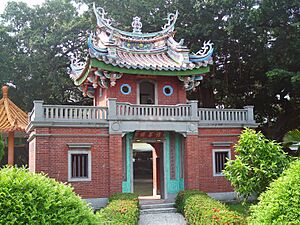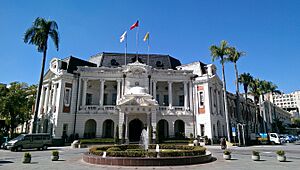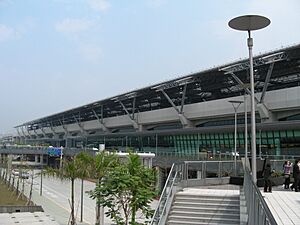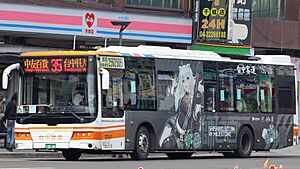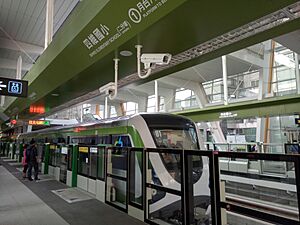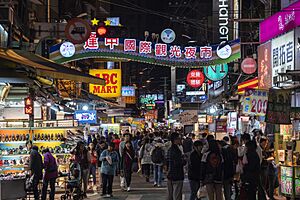Taichung facts for kids
Quick facts for kids
Taichung City
臺中市
|
|||
|---|---|---|---|
|
Special municipality
|
|||
|
Clockwise from top: Taichung's 7th Redevelopment Zone, Taichung railway station, Luce Memorial Chapel, Taichung Intercontinental Baseball Stadium, Gaomei Wetlands, Nanhu Mountain, National Museum of Natural Science
|
|||
|
|||
| Etymology: Taichū (Japanese: 臺中, Taiwan center) | |||
| Nickname(s):
Cultural City (文化城)
|
|||
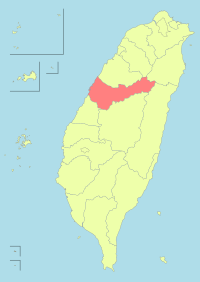 |
|||
| Country | |||
| Established | 1887 | ||
| Provincial city status | 25 October 1945 | ||
| Upgraded to special municipality and merger with Taichung County | 25 December 2010 | ||
| Seat | Xitun District | ||
| Districts |
29
Central
East West South North Xitun Nantun Beitun Fengyuan Dongshi Dajia Qingshui Shalu Wuqi Houli Shengang Tanzi Daya Xinshe Shigang Waipu Da'an Wuri Dadu Longjing Wufeng Taiping Dali Heping |
||
| Government | |||
| • Body |
|
||
| Area | |||
| • Special municipality | 2,214.90 km2 (855.18 sq mi) | ||
| • Urban | 492 km2 (190 sq mi) | ||
| Area rank | 6 out of 22 | ||
| Population
(April 2024)
|
|||
| • Special municipality | 2,850,285 | ||
| • Rank | 2 out of 22 | ||
| • Density | 1,286.8685/km2 (3,332.974/sq mi) | ||
| • Urban | 2,635,000 | ||
| • Urban density | 5,356/km2 (13,871/sq mi) | ||
| Time zone | UTC+8 (National Standard Time) | ||
| Postal code |
400-439
|
||
| Area code(s) | (0)4 | ||
| ISO 3166 code | TW-TXG | ||
| Bird | White-eared sibia | ||
| Flower | Taiwan cherry | ||
| Tree | Taiwan white pine | ||
| Taichung City | |||||||||||||||||||||||||||||||||||||||
|---|---|---|---|---|---|---|---|---|---|---|---|---|---|---|---|---|---|---|---|---|---|---|---|---|---|---|---|---|---|---|---|---|---|---|---|---|---|---|---|

"Taichung" in Traditional (top) and Simplified (bottom) Chinese characters
|
|||||||||||||||||||||||||||||||||||||||
| Chinese name | |||||||||||||||||||||||||||||||||||||||
| Traditional Chinese | 臺中市 | ||||||||||||||||||||||||||||||||||||||
| Simplified Chinese | 台中市 | ||||||||||||||||||||||||||||||||||||||
| Literal meaning | "Tai[wan] Central" | ||||||||||||||||||||||||||||||||||||||
|
|||||||||||||||||||||||||||||||||||||||
| Japanese name | |||||||||||||||||||||||||||||||||||||||
| Hiragana | たいちゅうし | ||||||||||||||||||||||||||||||||||||||
| Katakana | タイチュウシ | ||||||||||||||||||||||||||||||||||||||
| Kyūjitai | 臺中市 | ||||||||||||||||||||||||||||||||||||||
| Shinjitai | 台中市 | ||||||||||||||||||||||||||||||||||||||
|
|||||||||||||||||||||||||||||||||||||||
Taichung is a big city in central Taiwan. It is officially called Taichung City. With over 2.85 million people, it's the second-largest city in Taiwan. It's also the main city in the Taichung–Changhua metropolitan area, which is Taiwan's second-biggest city area.
Taichung is in the Taichung Basin. It started as small villages where Taiwanese indigenous peoples lived. Between 1887 and 1894, it was planned to be the new capital of Taiwan Province and was called "Taiwan-fu". When Japan ruled Taiwan from 1895, they planned and developed the modern city. In 2010, Taichung City and Taichung County joined together to form a new, larger special municipality.
The city has many cool places to visit. These include the National Museum of Natural Science, the National Taiwan Museum of Fine Arts, and the National Taichung Theater. You can also find historic spots like Taichung Park and old temples.
Contents
- History of Taichung City
- Geography and Climate of Taichung
- Population and People of Taichung
- Districts and Administration
- Economy and Industries
- Getting Around Taichung: Transportation
- Education in Taichung
- Culture and Fun in Taichung
- Sports in Taichung
- Hospitals in Taichung
- Famous People from Taichung
- Sister Cities Around the World
- Images for kids
- Relative Location
- See also
History of Taichung City
Early Life in Taichung
Long ago, different groups of Taiwanese indigenous peoples lived in the plains where Taichung is now. These included the Atayal, Taokas, Papora, Pazeh, Hoanya, and Babuzas tribes. They used to hunt and gather food. Later, they learned to grow crops like millet and taro. In the 1600s, some of these tribes formed the Kingdom of Middag. This kingdom covered the western part of today's Taichung.
Taichung During the Qing Dynasty
In 1684, the Qing dynasty set up Zhuluo County, which included most of northern Taiwan. Taichung began as a settlement called Toatun in 1705. To make their control stronger, the Qing government built a military camp near what is now Taichung Park in 1721.
In 1731, a rebellion started north of the city. This happened after Chinese officials made the local people work for them. The rebellion spread through the city. In 1786, another big rebellion, led by Lin Shuangwen, tried to overthrow the Qing government. The rebels caused a lot of trouble as they moved north. Finally, the Qing forces, along with local volunteers, defeated them.
In 1887, Taiwan became its own province. The government wanted to build the new capital city in Toatun, which was in the center of the island. They named it "Taiwan-fu," meaning "capital city of Taiwan." An official named Liu Ming-chuan started building a railway through the city. However, the capital was later moved to Taipei.
Taichung Under Japanese Rule
After the Qing dynasty lost a war to Japan in 1895, Taiwan was given to Japan. The city's name was changed to Taichū. The Japanese wanted to make Taichung a "modern" city. They built new roads, dams, and river walls. In 1901, Taichū became one of the island's main administrative areas. By 1904, the town of Taichū had over 6,400 people.
Taichung Park was finished in 1903. An old gate tower was moved to the park, where it still stands today. The first market in Taichū was built in 1908 and is still used. The Japanese also built a railway across the island. The Taichū Train Station opened in 1917 and is still busy today. Taichū City was officially named in 1920. Its city hall was completed in 1924. Taichung Airport, then called Kōkan Airport, was also built during this time.
In 1915, Taichū Middle School (now Taichung First Senior High School) was started. Wealthy local leaders like Lin Hsien-tang wanted to teach children about culture of Taiwan. They also wanted to support the Taiwanese localization movement. The Taiwanese Cultural Association, which started in Taipei, moved to Taichū in 1927. Many of its members were from Taichung, making the city a center for Taiwanese culture and national pride.
From 1926 to 1945, Taichū Prefecture included modern-day Taichung, Changhua County, and Nantou County.
Taichung in the Republic of China Era
In October 1945, Taiwan was given back to the Republic of China. Taichung County was created, covering the area of today's Taichung City, Miaoli County, and Taoyuan City. In 1947, Lai Tien Shen became the first mayor. In 1949, Taichung also served as a temporary capital for the Jiangxi provincial government. In 1950, Miaoli and Taoyuan became separate counties.
In June 2009, the government decided to combine Taichung City and Taichung County. On December 25, 2010, they merged to form a larger special municipality. This new Taichung City had 2.65 million people and covered about 2,214 square kilometers. In 2020, Taichung was recognized as a "Gamma" level global city, meaning it's an important city worldwide.
Geography and Climate of Taichung
Where is Taichung City Located?
Taichung City is in the Taichung Basin. This basin is part of the main flat area along Taiwan's western coast. The city shares borders with Changhua County, Nantou County, Hualien County, Yilan County, Hsinchu County, and Miaoli County.
The Central Mountain Range is just east of the city. To the north, there are rolling hills leading to Miaoli County. To the south, flat coastal plains stretch towards Changhua County. The Taiwan Strait is to the west. The Dadu Plateau is in the northwest.
What is Taichung's Climate Like?
Taichung has a warm climate, like a humid subtropical or tropical monsoon climate. The average temperature each year is about 23.3°C (73.9°F). The hottest months are July and August, while January and February are the coolest. Daytime temperatures are warm all year. However, winter nights are much cooler than summer nights.
Taichung gets about 1700 mm (67 inches) of rain each year. This is less rain compared to other big cities in Taiwan. The air is usually quite humid, around 80%. The Central Mountain Range to the east and the Miaoli hills to the north protect Taichung. Because of this, strong typhoons rarely hit the city directly. But typhoons from the South China Sea can sometimes be a threat.
Population and People of Taichung
| Historical population | ||
|---|---|---|
| Year | Pop. | ±% |
| 1960 | 903,556 | — |
| 1966 | 1,084,795 | +20.1% |
| 1970 | 1,234,043 | +13.8% |
| 1975 | 1,408,444 | +14.1% |
| 1980 | 1,606,603 | +14.1% |
| 1985 | 1,817,125 | +13.1% |
| 1990 | 2,019,959 | +11.2% |
| 1995 | 2,257,950 | +11.8% |
| 2000 | 2,460,098 | +9.0% |
| 2005 | 2,587,828 | +5.2% |
| 2010 | 2,648,419 | +2.3% |
| 2015 | 2,744,445 | +3.6% |
| 2020 | 2,820,787 | +2.8% |
| Source: | ||
In March 2020, Taichung's population was about 2,816,667 people. There are slightly more females than males in the city. About 24% of residents are children. Young people make up 16.6% of the population. Middle-aged people are 52.7%, and elderly people are 6.7%. In 2007, the birth rate in Taichung City was 1.165 babies per woman.
In July 2017, Taichung became the second-largest city in Taiwan. It grew very quickly from 2012 to 2017. More people are moving to the city. Also, the population is growing naturally, and there is help for housing.
Districts and Administration
Taichung has 29 districts. There are 28 regular districts and 1 mountain indigenous district. The inner part of Taichung refers to the eight districts that were part of Taichung City before it merged with Taichung County in 2010. Heping District is also a special area for the Atayal people.
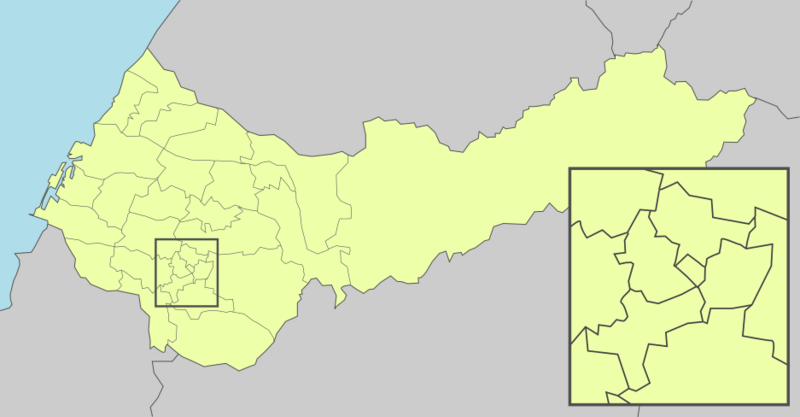
Xinshe
Tanzi
Shigang
Shengang
Houli
Heping
Fengyuan
Dongshi
Daya
Wuqi
Waipu
Shalu
Qingshui
Longjing
Dajia
Dadu
Daan
Xitun
Wuri
Wufeng
West
Taiping
South
North
Nantun
East
Dali
Central
Beitun
Nantou County
|
|||||
| Name | Chinese | Taiwanese | Hakka | Population (January 2023) | Area (km2) |
|---|---|---|---|---|---|
| Central | 中區 | Tiong | Chûng | 17,654 | 0.8803 |
| East | 東區 | Tang | Tûng | 75,724 | 9.2855 |
| South | 南區 | Lâm | Nàm | 125,695 | 6.8101 |
| West | 西區 | Se | Sî | 112,651 | 5.7042 |
| North | 北區 | Pak | Pet | 143,018 | 6.9376 |
| Beitun (Beituen) | 北屯區 | Pak-tūn | Pet-tun | 296,757 | 62.7034 |
| Xitun (Shituen) | 西屯區 | Se-tūn | Sî-tun | 232,406 | 39.8467 |
| Nantun (Nantuen) | 南屯區 | Lâm-tūn | Nàm-tun | 178,446 | 31.2578 |
| Taiping | 太平區 | Thài-pêng | Thai-phìn | 196,327 | 120.7473 |
| Dali | 大里區 | Tāi-lí | Thai-lî | 211,768 | 28.8758 |
| Wufeng (Wufong) | 霧峰區 | Bū-hong | Vú-fûng | 64,093 | 98.0779 |
| Wuri (Wurih) | 烏日區 | O·-ji̍t | Vû-ngit | 78,343 | 43.4032 |
| Fengyuan (Fongyuan) | 豐原區 | Hong-goân | Fûng-ngièn | 163,699 | 41.1845 |
| Houli | 后里區 | Aū-lí | Heu-lî | 53,716 | 58.9439 |
| Shigang (Shihgang) | 石岡區 | Chio̍h-kng | Sa̍k-kóng | 14,166 | 18.2105 |
| Dongshi (Dongshih) | 東勢區 | Tang-sì | Tûng-sṳ | 47,789 | 117.4065 |
| Xinshe (Sinshe) | 新社區 | Sin-siā | Sîn-sa | 23,266 | 68.8874 |
| Tanzi (Tanzih) | 潭子區 | Thâm-chú | Thâm-tsṳ́ | 108,790 | 25.8497 |
| Daya | 大雅區 | Tāi-ngé | Thai-ngâ | 95,419 | 32.4109 |
| Shengang | 神岡區 | Sin-kóng | Sṳ̀n-kông | 64,374 | 35.0445 |
| Dajia | 大甲區 | Tāi-kah | Thai-kap | 74,866 | 58.5192 |
| Qingshui (Cingshuei) | 清水區 | Chheng-chúi | Tshîn-súi | 89,145 | 64.1709 |
| Shalu | 沙鹿區 | Soa-la̍k | Sâ-lu̍k | 97,201 | 40.4604 |
| Wuqi (Wuci) | 梧棲區 | Gō·-chhe | Ǹg-tshi | 59,933 | 18.4063 |
| Daan (Da'an) | 大安區 | Tāi-an | Thai-ôn | 18,208 | 27.4045 |
| Dadu | 大肚區 | Tōa-tō͘ | Thai-tú | 56,155 | 37.0024 |
| Longjing | 龍井區 | Liông-chéⁿ | Liùng-tsiáng | 78,012 | 38.0377 |
| Waipu | 外埔區 | Goā-po͘ | Ngoi-phû | 31,256 | 42.4099 |
| Heping | 和平區 | Hô-pêng | Fò-phìn | 10,921 | 1037.8192 |
Economy and Industries
Taichung is the main business center in Central Taiwan. Its biggest industries are making machines and selling things in stores.
The city has many factories. Six main types of manufacturing happen here: tool machines, mechanical parts, photoelectric panels, bicycles, woodworking machines, and aerospace parts. The Taichung Industrial Park in Xitun District has many factories. The nearby World Trade Center Taichung hosts many industry events. Taichung is also home to the Central Taiwan Science Park. This park is famous for its many semiconductor factories, like TSMC. Other well-known companies in Taichung include Aerospace Industrial Development Corporation, HIWIN, Largan Precision, and Pou Chen Corporation.
Taichung is also known for making bicycles. Big companies like Giant Bicycles, SRAM, and TRP Brakes are located here.
The financial heart of Taichung is the Taichung's 7th Redevelopment Zone. Many company offices are located there. Selling goods in stores is another major industry. Almost a quarter of all workers in Taichung work in retail. The value of goods sold is 1.3 trillion NTD. This is the second highest in Taiwan, after Taipei.
Taichung is very famous for its suncakes. Also, the Chun Shui Tang teahouse in Taichung is where bubble tea was first created!
| Years | 1975 | 1980 | 1985 | 1990 | 1995 | 2000 | 2005 | 2010 | 2015 |
|---|---|---|---|---|---|---|---|---|---|
| Primary industry(%) | 35.6 | 32.5 | 27.7 | 9.5 | 7.7 | 5.0 | 3.9 | 3.1 | 3.1 |
| Secondary industry(%) | 28.3 | 32.4 | 36.5 | 47.6 | 43.5 | 41.0 | 39.1 | 40.0 | 40.1 |
| Tertiary industry(%) | 36.1 | 35.1 | 35.7 | 42.9 | 48.7 | 54.0 | 57.0 | 56.8 | 56.8 |
Getting Around Taichung: Transportation
Train Travel in Taichung
Taichung has two main train lines. The Taichung Line goes through the city's busy areas. The West Coast Line runs closer to the coast. The main Taichung railway station is in the heart of the city. Many bus companies connect you to other towns from here.
The THSR Taichung Station is in the Wuri district. It serves both Taichung City and northern Changhua County. You can get to the High Speed Rail station by local trains or the MRT Green Line. Free shuttle buses also take you into the city.
Taichung's Seaport
Taichung Port is on the coast. It is the second-largest cargo port in Taiwan. It can handle many shipping containers. However, there are no passenger ferries here. The port is closed to people without special permission.
Roads and Highways
Taichung's roads spread out from the Taichung railway station. Major roads like Taiwan Boulevard and Zhongqing Road start downtown and go outwards.
Freeway 1 runs around the city's edge. Freeway 3 runs along the Dadu River and then parallel to the coast. Freeway 4 goes from Qingshui District to Fengyuan District. Highway 74 circles the city, and Highway 63 goes south to Nantou. Many other highways also pass through the city. Most road signs have English spellings.
Bus System
Buses are the most popular way to get around Taichung. There are 18 bus companies with 275 routes covering all districts. Bus stops announce names in both Mandarin and English. If you use a special smartcard, the first 10 kilometers of your ride are free. Some taxis also act as bus routes in country areas.
MRT and Public Transit
The city has one MRT line, the Green line, which opened in April 2021. A second line, the Blue line, was approved in 2024 and should open around 2034.
For a short time, Taichung had a special bus system called the BRT Blue Line. It used long buses in a special lane. This was new for Taiwan. It started in July 2014 but didn't help traffic much. It was stopped within a year. Now, the special lane and bus stops are used by regular bus lines.
Taichung International Airport
Taichung International Airport is Taiwan's third and newest international airport. It is part of the Ching Chuan Kang Air Base. The airport is about 20 kilometers (12 miles) from downtown Taichung City. It replaced the old Shuinan Airport in 2004.
Education in Taichung

In 1915, Taichung Middle School (now Taichung Municipal Taichung First Senior High School) was the first school for young people in Taiwan. In 1943, the Advanced Academy of Agronomy and Forestry (now National Chung Hsing University) moved to Taichung. This marked the start of higher education in the city. In 1955, Tunghai University opened. It was the first private university in Taiwan.
Today, Taichung has 17 universities. There are also 50 high schools, 71 junior high schools, and 235 elementary schools. The city also has special schools, international schools, and community colleges.
Culture and Fun in Taichung
Museums and Cultural Places
- The National Taiwan Museum of Fine Arts has the world's largest collection of Taiwanese art.
- National Museum of Natural Science is one of Taiwan's big museums. It covers 22 acres and has six areas. These include a Space IMAX Theater, Science Center, Life Science Hall, and a Botanical Garden. It also has an Earthquake Museum nearby. The museum has over 30 permanent exhibits. They cover topics like space, dinosaurs, plants, and Taiwanese Indigenous cultures.
- Taichung Municipal Cultural Center: This center is next to the National Taiwan Museum of Fine Arts.
- Taichung Folklore Park: This park shows what traditional Taiwanese life was like. It has real and copied buildings and streets.
- 921 Earthquake Museum of Taiwan: This museum is in Wufeng District. It shows the damage from a big earthquake in 1999. It also teaches people about earthquakes and how to be ready for them.
- Asia Museum of Modern Art: This museum is at Asia University in Wufeng District. It was designed by a famous architect, Tadao Ando. The museum has many amazing exhibits of Asian and modern art.
Temples of Taichung
Taichung has many temples, and some are very old and important. A survey in 2018 found 1,012 registered temples. Most are Taoist, and some are Buddhist.
The Goddess Mazu is very popular. Jenn Lann Temple is where the yearly Dajia Mazu Pilgrimage starts. This is one of the biggest pilgrimages in Taiwan. Worshippers carry a statue of Mazu and walk 340 kilometers to Xingang and back. Lecheng Temple has a similar pilgrimage for good luck. Other famous Mazu temples include Wanhe Temple and Haotian Temple.
Confucianism is important in Chinese culture. In Taichung, there are two old temples for Wenchang Dijun, the god of literature. These are Beitun Wenchang Temple and Nantun Wenchang Temple. The Taichung Confucian Temple is a large, newer temple for Confucius himself. There are also several ancestral shrines, like the Lin Family Ancestral Shrine.
Many other gods are worshipped in the city, including:
- Baosheng Dadi at Yuanbao Temple
- Guanyin at Songzhu Temple and Zi Yun Yan
- Xuantian Shangdi at Zhenwu Temple
Night Markets for Food and Fun
Taichung has several outdoor night markets. They are great places to find local food and entertainment:
- Fengjia Night Market - This market is next to Feng Chia University.
- Yizhong Street - Located in North District, near Taichung Park. It's one of the most popular night markets.
- Zhonghua Night Market - Found in the center of Central District, along ZhongHua Road.
- Zhongxiao Night Market - South of the Taichung Railroad Station.
- Tunghai Night Market - West of Xitun, near Tunghai University.
- Hanxi Night Market - A large market in East District.
Hot Springs to Relax
Taichung has a famous hot spring called Guguan hot spring. It is located in Heping District.
Performance Venues
- Zhongshan Hall: This is a popular place for music, opera, ballet, and plays. It can seat 1,692 people.
- Fulfillment Amphitheater: This outdoor venue is in Wenxin Forest Park. It's great for many kinds of outdoor shows.
Annual Activities and Festivals
- The Taichung Jazz Festival happens every October. It features many different performers at various places around the city.
Sports in Taichung
Professional Sports Teams
Taichung has two professional basketball teams. These are the Taichung Suns in the T1 League and the Formosa Taishin Dreamers in the P. League+. The CTBC Brothers baseball team also calls Taichung Intercontinental Baseball Stadium their home field.
Major Sporting Events Hosted in Taichung
The Cup Marathon is held on the city's streets every autumn. Taichung has hosted many big sports events, including:
- 2013 18U Baseball World Cup
- 2014 U-21 Baseball World Cup
- 2015 WBSC Premier12 (co-hosted)
- 2019 Asian Baseball Championship
- 2019 WBSC Premier12 (co-hosted)
- 2022 U-23 Baseball World Cup (co-hosted)
- 2023 World Baseball Classic (Pool A)
- 2023 U-18 Baseball World Cup (Co-hosted)
Hospitals in Taichung
- China Medical University Hospital
- Chung Shan Medical University Hospital
- Taichung Veterans Hospital
- Cheng Ching Hospital
- Jen-Ai Hospital - Dali
- Jen-Ai Hospital - Taichung
- Taichung Tzu Chi General Hospital
- Taichung armed force general hospital
- Asia University Hospital
Famous People from Taichung
- Chen Xue: a writer
- Lin Xian Tang: a scholar and politician
- Teng Ming-Tun: an artist
Sister Cities Around the World
Taichung has made special agreements with many cities in other countries. These are called sister city agreements. Since 1965, Taichung has partnered with nineteen cities in nine countries.
 New Haven, Connecticut, United States (March 29, 1965)
New Haven, Connecticut, United States (March 29, 1965) Chungju, North Chungjeong, South Korea (November 27, 1969)
Chungju, North Chungjeong, South Korea (November 27, 1969) Santa Cruz de la Sierra, Bolivia (November 21, 1978)
Santa Cruz de la Sierra, Bolivia (November 21, 1978) Tucson, Arizona, United States (August 31, 1979)
Tucson, Arizona, United States (August 31, 1979) Baton Rouge, Louisiana, United States (April 18, 1980)
Baton Rouge, Louisiana, United States (April 18, 1980) Cheyenne, Wyoming, United States (October 8, 1981)
Cheyenne, Wyoming, United States (October 8, 1981) Winnipeg, Manitoba, Canada (April 2, 1982)
Winnipeg, Manitoba, Canada (April 2, 1982) Contra Costa County, California, United States (March 31, 1983)
Contra Costa County, California, United States (March 31, 1983) San Diego, California, United States (November 19, 1983)
San Diego, California, United States (November 19, 1983) Pietermaritzburg, KwaZulu-Natal, South Africa (December 9, 1983)
Pietermaritzburg, KwaZulu-Natal, South Africa (December 9, 1983) Reno, Nevada, United States (October 8, 1985)
Reno, Nevada, United States (October 8, 1985) Sumter County, South Carolina, United States (June 5, 1986)
Sumter County, South Carolina, United States (June 5, 1986) Austin, Texas, United States (September 22, 1986)
Austin, Texas, United States (September 22, 1986) Manchester, New Hampshire, United States (May 8, 1989)
Manchester, New Hampshire, United States (May 8, 1989) Mexicali, Baja California, Mexico (September 21, 1989)
Mexicali, Baja California, Mexico (September 21, 1989) Guadalajara, Jalisco, Mexico (September 24, 1989)
Guadalajara, Jalisco, Mexico (September 24, 1989) Montgomery County, Ohio, United States (October 15, 1990)
Montgomery County, Ohio, United States (October 15, 1990) North Shore City (December 17, 1996)/Auckland (October 14, 2012), New Zealand
North Shore City (December 17, 1996)/Auckland (October 14, 2012), New Zealand Nassau County, New York, United States (September 4, 1997)
Nassau County, New York, United States (September 4, 1997) Tacoma, Washington, United States (July 19, 2000)
Tacoma, Washington, United States (July 19, 2000) Kwajalein Atoll, Marshall Islands (July 19, 2002)
Kwajalein Atoll, Marshall Islands (July 19, 2002) San Pedro Sula, Honduras (October 28, 2003)
San Pedro Sula, Honduras (October 28, 2003) Makati, Metro Manila, Philippines (July 27, 2004)
Makati, Metro Manila, Philippines (July 27, 2004) Columbus, Georgia, United States (November 11, 2007)
Columbus, Georgia, United States (November 11, 2007) Columbia, South Carolina, United States (March 12, 2014)
Columbia, South Carolina, United States (March 12, 2014) Gwangyang, South Jeolla, South Korea (November 14, 2017)
Gwangyang, South Jeolla, South Korea (November 14, 2017) Petah Tikva, Central, Israel (February 14, 2018)
Petah Tikva, Central, Israel (February 14, 2018) Ulaangom, Mongolia (November 4, 2018)
Ulaangom, Mongolia (November 4, 2018) Nagoya, Aichi, Japan (October 25, 2019)
Nagoya, Aichi, Japan (October 25, 2019) Guam, United States (February 23, 2022)
Guam, United States (February 23, 2022)
Images for kids
Relative Location
 |
 |
|||
| Taiwan Strait (South China Sea) | ||||
| Nantou County |
See also
 In Spanish: Taichung para niños
In Spanish: Taichung para niños











